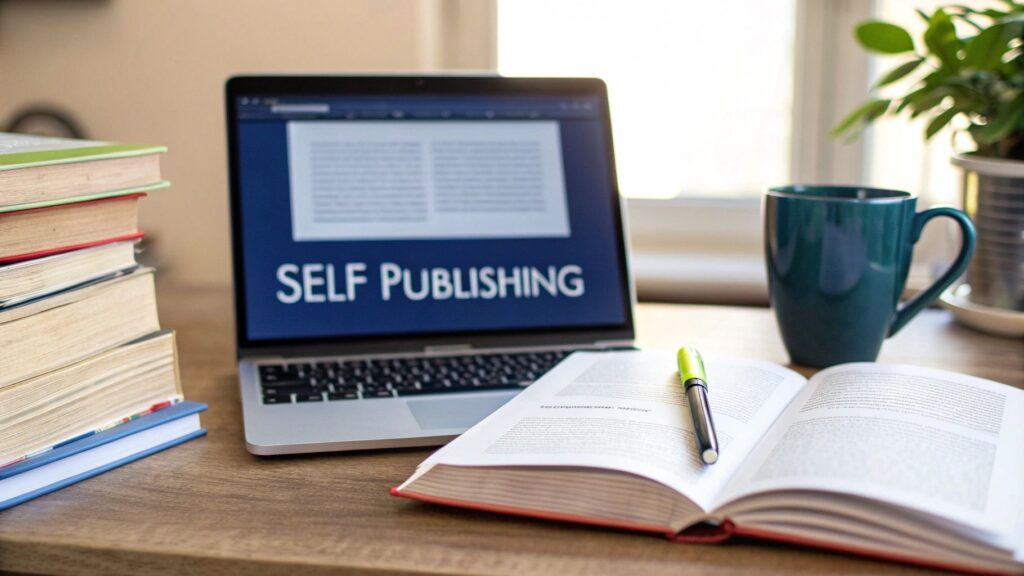Self-publishing is exactly what it sounds like: you, the author, take the reins of the entire publishing process. Instead of signing over your rights to a traditional publisher, you steer the ship from editing and design all the way through to distribution and marketing. It’s a lot of work, but the payoff is huge—think complete creative freedom, much higher royalty rates, and a direct, faster path to getting your book into readers' hands.
In short, you become the CEO of your own book.
Why Self-Publishing Is a Smart Move for Authors
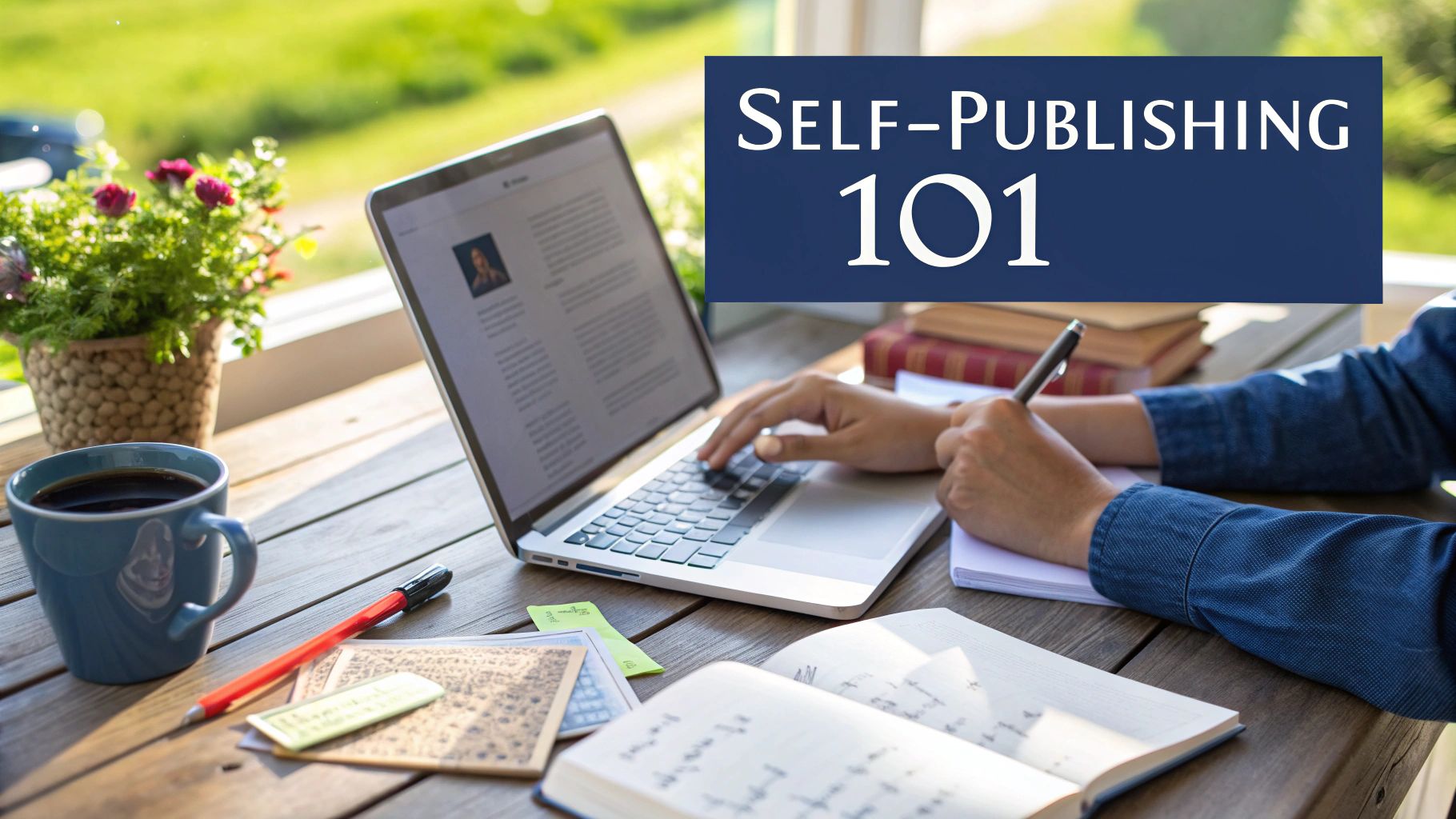
Let's be real—the thought of going it alone can be daunting. But what if it’s actually the most powerful way to get your story out there? The old stigma of self-publishing as a "vanity" project is dead and buried. Today, it’s a legitimate, strategic business decision made by countless successful authors.
The numbers don't lie. In 2023, the number of self-published titles with registered ISBNs shot up to over 2.6 million. That’s a 7.2% jump from the previous year, while traditional publishing actually saw a decline. You can dig into more of the data on this market shift over on PR Newswire.
This isn’t just a passing trend. It's a fundamental change in how books find their audience. For many writers, the benefits are just too good to pass up.
You Maintain Full Creative Control
When you self-publish, you’re the boss. Period. You have the final say on every single detail, which means the finished product is exactly what you envisioned.
- Cover Design: You get to choose the art, the fonts, and the overall vibe. No more settling for a generic cover that fits a publisher's cookie-cutter marketing plan.
- Title and Content: The title you love stays. No one can force you to rewrite a chapter, kill off a character, or soften an argument in your non-fiction manuscript.
- Series Pacing: This is a game-changer for fiction authors. You can release books in your series at your own pace, keeping your readers hooked without the agonizing multi-year wait for a sequel.
Taking the helm of your own creative work is the single most empowering part of self-publishing. It ensures the book people buy is the exact book you set out to write.
Higher Royalties and Financial Upside
The money side of things is where the difference becomes incredibly clear. With a traditional publisher, you’re lucky to see royalties in the 7-15% range. But when you self-publish on a platform like Amazon KDP, you can earn up to 70% royalties on ebooks.
That massive jump in profit-per-book means you can earn a real income without having to sell a bazillion copies. You set your own price, run your own sales, and the profits go directly to you. For any author serious about building a career, learning https://barkerbooks.com/how-to-become-a-published-author/ on your own terms is the critical first step.
Faster Speed to Market
Finally, let's talk about time. The traditional route can take a painfully long 18-24 months from the day you sign a contract to the day your book hits shelves.
An independent author? You can go from a polished final draft to a published book available worldwide in a matter of weeks. This agility means you can capitalize on current events, publish timely non-fiction, and keep your momentum going without the frustrating, drawn-out delays of the old-school publishing world.
Turning Your Manuscript Into a Professional Book
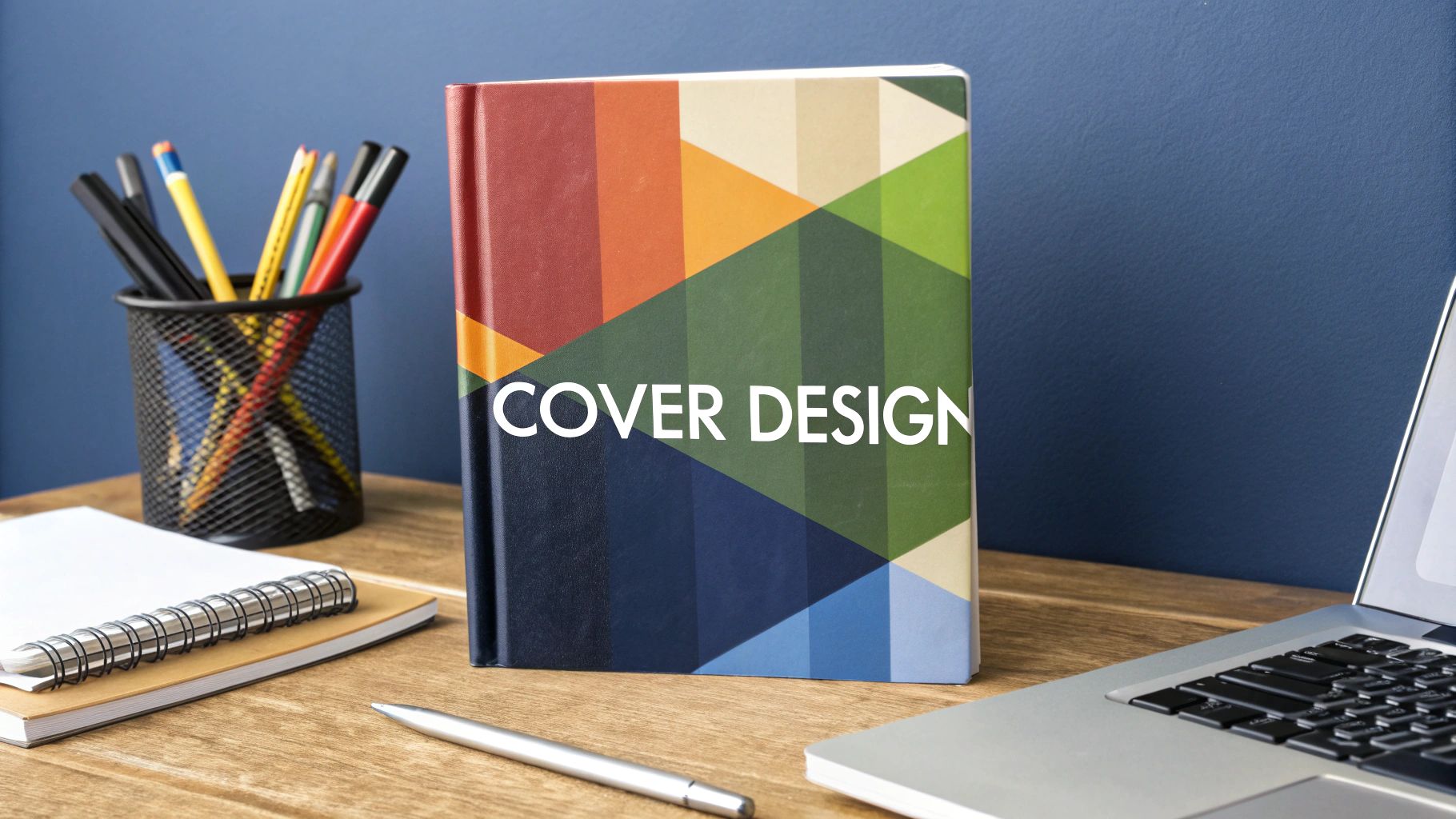
You’ve done the hard part—you’ve poured your heart and soul into thousands of words. Now comes the transition from creator to craftsman. This is the critical phase where your manuscript evolves into a polished, professional book that readers will love.
And it all starts with editing.
Let me be blunt: skipping professional editing is the single biggest mistake a self-publishing author can make. See it as an investment in your book's credibility, not a cost. A well-edited book immediately tells readers you’re a professional who respects their time.
The Different Layers of Editing
Editing isn't just one step; it's a series of focused passes, each with a different goal. Think of it like building a house—you can't paint the walls before the frame is up. To get the best results, you have to tackle these in the right order.
Here’s a breakdown of the editing stages every author should know:
- Developmental Editing: This is the 30,000-foot view. A developmental editor looks at your book’s core structure—the plot, character arcs, pacing, and themes. They’ll ask the tough questions. Does your main character’s motivation hold up? Is the ending satisfying? This is where you fix the foundational story itself.
- Line Editing: With a solid structure in place, the line editor goes to work on your prose, sentence by sentence. Their job is to make your writing sing. They'll tighten clunky phrases, improve the rhythm of your paragraphs, and ensure your unique voice shines through consistently.
- Copyediting: This is the nitty-gritty, technical cleanup. Your copyeditor is a stickler for the rules. They hunt down typos, grammatical errors, punctuation mistakes, and continuity slip-ups. Did you spell a character's name two different ways? Did you accidentally switch from past to present tense? A good copyeditor catches it all.
Finding the Right Editor for Your Book
So, where do you find these magical people? It can feel a bit overwhelming, but there are excellent resources out there. My go-to recommendation is Reedsy, which is a curated marketplace of vetted, top-tier publishing professionals. You can browse editor profiles, see their portfolios, and find someone who specializes in your exact genre.
When you're looking for an editor, check for experience in your genre—the person who edits thrillers might not be the best fit for your historical romance. Always ask for a sample edit of your first 1,000 words or so. Most editors offer this for free or a small fee, and it’s the best way to see if their style and feedback resonate with you.
A great editor doesn't just correct your mistakes. They see the potential in your story and give you the tools to elevate it. Their feedback should feel like a collaboration, empowering you to make your book the best it can be.
A Quick Example of Editing in Action
Let’s say you wrote a sentence like this: "He walked very slowly across the big, empty room, feeling sad."
It works, but it doesn't really pull the reader in. A line editor might suggest something more powerful:
"He trudged across the cavernous room, each footstep echoing the hollow ache in his chest."
See the difference? We replaced weak, generic words ("walked very slowly," "big," "sad") with evocative language that shows the character's emotion instead of just telling it. That’s the magic of good editing.
Investing in these stages is what separates an amateur-looking book from a professional one. It builds trust with your readers, generates better reviews, and gives your story the powerful launch it deserves. You’ve worked too hard to let preventable errors hold you back.
Designing a Book People Want to Buy
You've spent months, maybe even years, pouring your heart into your manuscript. You’ve edited it until your eyes crossed. Now comes the part that feels completely different but is just as crucial: packaging your story so readers will actually pick it up.
In the self-publishing game, your book’s design isn't just decoration—it's your number one sales tool. Think of it this way: the cover is your storefront window, and the interior layout is the shopping experience. You need both to be stellar.
Let's get one thing straight: people absolutely judge a book by its cover. On a crowded digital marketplace like Amazon, your cover has less than a second to grab someone's attention. A professional cover instantly communicates genre, tone, and quality. A bad one just screams "amateur," and potential readers will scroll right past, no matter how amazing your story is.
Crafting a Cover That Sells
Your cover's main job is to hook the right readers. A design that works wonders for a gritty, hard-boiled detective novel will completely turn off someone looking for a sweet, contemporary romance. The secret is to learn and speak the visual language of your genre.
Go spend an hour browsing the bestseller lists for your specific category on Amazon. What do you notice?
- Thriller Covers: They often use dark, high-contrast palettes—think black, red, and yellow. The fonts are typically bold and sans-serif, creating a feeling of tension and danger.
- Romance Covers: Right now, illustrated characters are a massive trend. You'll see a lot of soft or vibrant colors and elegant, flowing script fonts that signal emotion and connection.
- Sci-Fi Covers: These tend to feature epic alien landscapes, sleek spaceships, or stylized, futuristic typography that immediately tells you this story isn't set in our world.
See the patterns? These aren't just clichés; they are powerful visual shortcuts. They tell a reader, "Hey, if you like books that look like this, you're going to love what's inside."
Your cover's first job is to fit in with its genre. Its second job is to stand out just enough to be interesting. It has to signal the right category while being compelling enough to make someone stop and click.
Beyond genre, you have to consider the thumbnail test. This is how most shoppers will first encounter your book. If your design is too busy or the details are too fine, it’s going to look like a blurry mess on a phone screen. Aim for a single, powerful focal point, make sure there’s high contrast between your title and the background, and choose a font that’s readable even when it’s tiny.
A Look Inside: Professional Interior Formatting
Once that brilliant cover gets a reader to click, the interior formatting takes over. Good formatting is invisible; it creates a seamless, enjoyable reading experience. Bad formatting, on the other hand, is a constant distraction that can yank a reader right out of the world you’ve built.
A professionally formatted book, whether it's for print or an e-reader, has a few non-negotiable elements:
- A Clean Title Page: This simply includes your book title, subtitle (if you have one), and your name.
- The Copyright Page: This is where you put your copyright notice, your ISBN, and any necessary credits or disclaimers.
- A Readable Body Font: For print books, stick with classic serif fonts like Garamond or Caslon. They’re designed for long-form reading and are easy on the eyes. For ebooks, simple sans-serif fonts like Arial or Helvetica can work just as well.
- Consistent Chapter Headings: Keep the style for your chapter numbers and titles the same throughout the book.
- Proper Margins and Spacing: Nobody likes a wall of text. Ample white space makes the pages feel inviting and less overwhelming.
The Big Decision: DIY Tools vs. Hiring a Pro
When it comes to actually creating your design, you have two main options: do it yourself, or hire a professional. Both paths are perfectly valid, and the best choice really comes down to your budget, skills, and how much time you have.
| Approach | Best For | Pros | Cons |
|---|---|---|---|
| DIY Tools (Vellum, Atticus) | Authors on a tighter budget or those who enjoy having complete creative control. | A one-time fee is much more affordable. You can make changes instantly without waiting on someone else. | It has a learning curve and requires your time. Customization can be limited compared to a pro. |
| Hiring a Designer (Reedsy, 99designs) | Authors who want a top-tier, custom design and prefer to spend their time on marketing or writing the next book. | You get a unique, market-tested design from an expert. It frees you up to focus on other things. | The cost is significantly higher. You have to spend time finding and vetting the right person for the job. |
For a lot of indie authors, especially when they're starting out, a tool like Vellum is an absolute game-changer. You pay for it once and can create an unlimited number of stunning, professionally formatted ebook and print files with just a few clicks. It’s the perfect middle ground if your budget is tight but you refuse to compromise on quality.
Ultimately, whether you invest your time or your money, putting a brilliant design on your book is one of the most important steps you can take toward self-publishing success.
Choosing the Right Publishing Platforms
Your manuscript is polished, your cover is ready to go, and now you’re at the most exciting part: getting your book into the hands of actual readers. This is the distribution stage, and the decisions you make here will dictate where your book is sold and how you get paid.
When it comes to self-publishing, you have two main routes you can take. You can go exclusive with one major retailer, or you can go wide and list your book across multiple stores. Neither path is right or wrong—it really comes down to your genre, how you plan to market your book, and what you want for your long-term author career.
The Elephant in the Room: Amazon KDP
Let's be honest, for most authors starting out, the journey begins and often ends with Amazon Kindle Direct Publishing (KDP). As the world's biggest bookseller, Amazon holds an estimated 60-80% of the ebook market. You can't ignore it. The real question is how you'll work with them.
Once you sign up, you'll get used to seeing this dashboard. It’s where all the magic happens.
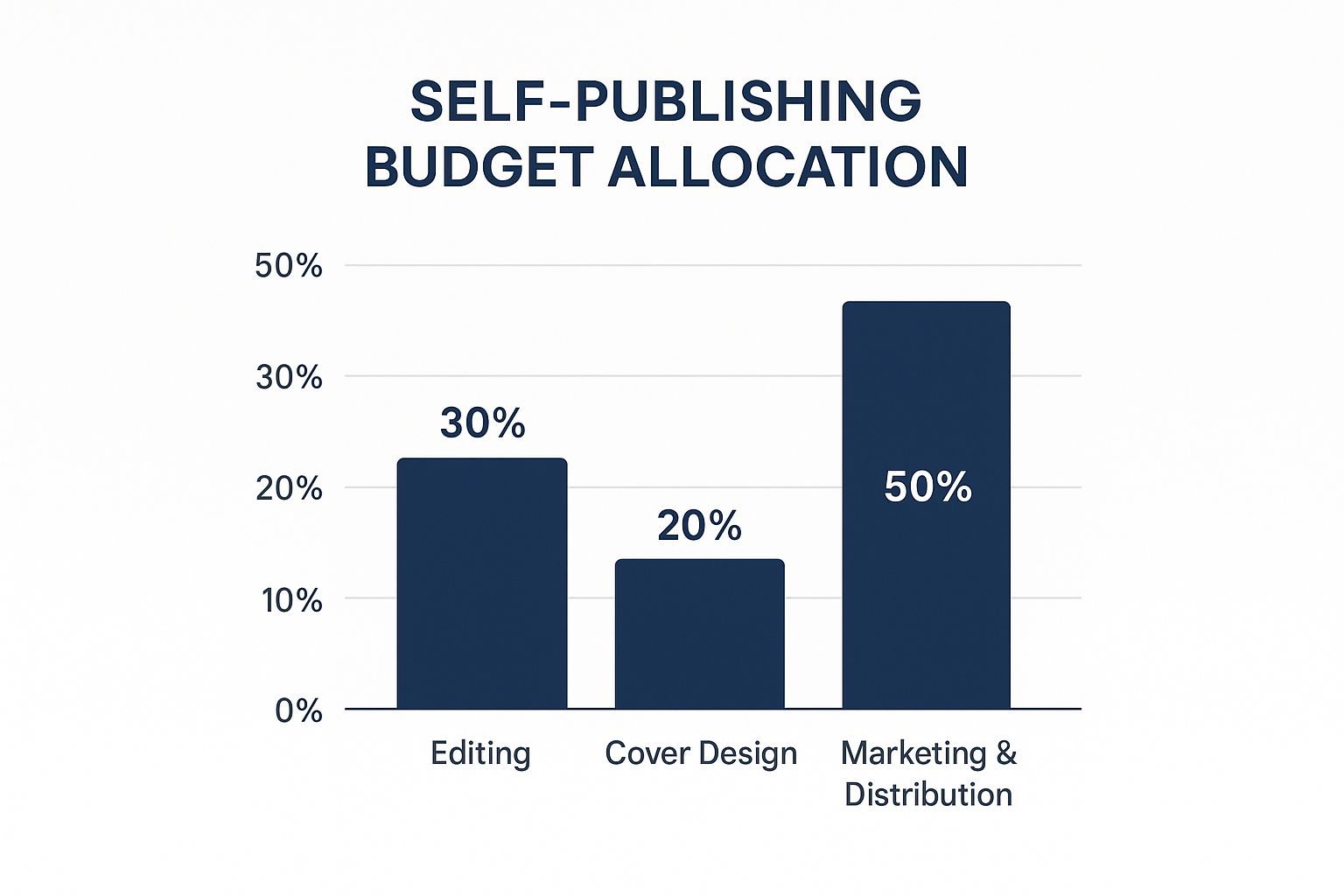
This simple interface is your mission control for uploading your book files, setting the price, writing your description, and, most importantly, tracking your sales.
Choosing to be exclusive with Amazon means enrolling your ebook in their KDP Select program. You’re locked in for 90-day periods, but in exchange, you get access to some powerful marketing tools that other authors can't use:
- Kindle Unlimited (KU): Your book joins Amazon's "Netflix for books" subscription service. Readers can borrow it for free, and you get paid for every page they read. It's a fantastic way to get discovered.
- Free Book Promotions: For up to five days each term, you can offer your book for free. This can lead to a massive spike in downloads and help you find a whole new audience.
- Kindle Countdown Deals: This lets you run a limited-time discount on your book, complete with a countdown timer that creates a real sense of urgency for potential buyers.
The catch? It’s a big one. Your ebook can't be sold anywhere else—not on Apple Books, not on Kobo, not even directly from your own author website.
Going Wide: Spreading Your Bets
The alternative to Amazon exclusivity is what we call "going wide." This strategy is all about making your book available on as many different retail platforms as you can. You could upload your files to each store one by one, but trust me, that's a massive headache. That's where aggregators come in.
Services like Draft2Digital and Smashwords are lifesavers. You upload your book just once to their platform, and they handle distributing it to a huge network of stores and libraries, including:
- Apple Books
- Barnes & Noble (Nook)
- Kobo
- OverDrive (the system for libraries)
- Dozens of smaller international retailers
By going wide, you diversify your income and build a readership that isn't tied to a single company. You’re essentially future-proofing your author business against Amazon's ever-changing rules. The main tradeoff, of course, is that you give up access to those tempting KDP Select promotional perks.
Comparing Key Self-Publishing Platforms
With so many options, it's easy to feel overwhelmed. To make it clearer, I've broken down the key players in this table. Think of it as a cheat sheet to help you see at a glance which platform might be the best starting point for you.
| Platform | Primary Reach | Royalty Rate (eBook) | ISBN Provision | Best For |
|---|---|---|---|---|
| Amazon KDP | Amazon's global marketplace | 35% or 70% | Free KDP ISBN (limited) | Authors wanting access to the largest market & Kindle Unlimited |
| Draft2Digital | Apple, B&N, Kobo, libraries, + more | ~60% (after their 10% cut) | Free D2D ISBN | Authors wanting wide distribution with minimal hassle |
| Smashwords | Apple, B&N, Kobo, OverDrive, Smashwords store | ~60% (after their ~10% cut) | Free Smashwords ISBN | Authors who want wide reach and a dedicated indie bookstore |
| Apple Books | Apple's global ecosystem (iPhones, iPads) | 70% | Requires your own ISBN | Authors with a Mac who want to directly reach Apple users |
| Barnes & Noble | US-based Nook readers | 40% or 65% | Requires your own ISBN | Authors targeting the dedicated B&N customer base directly |
Ultimately, the choice between exclusive and wide isn't permanent. You can always switch strategies after a KDP Select term ends. Many authors I know start with KDP Select to build initial momentum and then go wide later to expand their reach.
Nailing the Financial and Marketing Details
Before you hit "publish," you need to get two final, crucial pieces right: your price and your book description.
Pricing is part art, part science. A great place to start is to research what other successful books in your genre are selling for. On KDP, you’ll want to price your ebook between $2.99 and $9.99 to qualify for the 70% royalty rate. Go outside that window, and your royalty plummets to 35%.
Your book description is your sales pitch. It has to be compelling. Start with a killer hook, introduce the central conflict or promise, and end with a line that makes someone feel like they have to click "Buy Now." These details might seem small, but they make a huge difference. You can find more in-depth advice on this in our complete guide on how to publish a book.
A successful launch isn't just about making your book available; it's about making it discoverable. Your platform choice, pricing, and book description all work together to convert a curious browser into a loyal reader.
Building a Simple and Effective Book Launch Plan
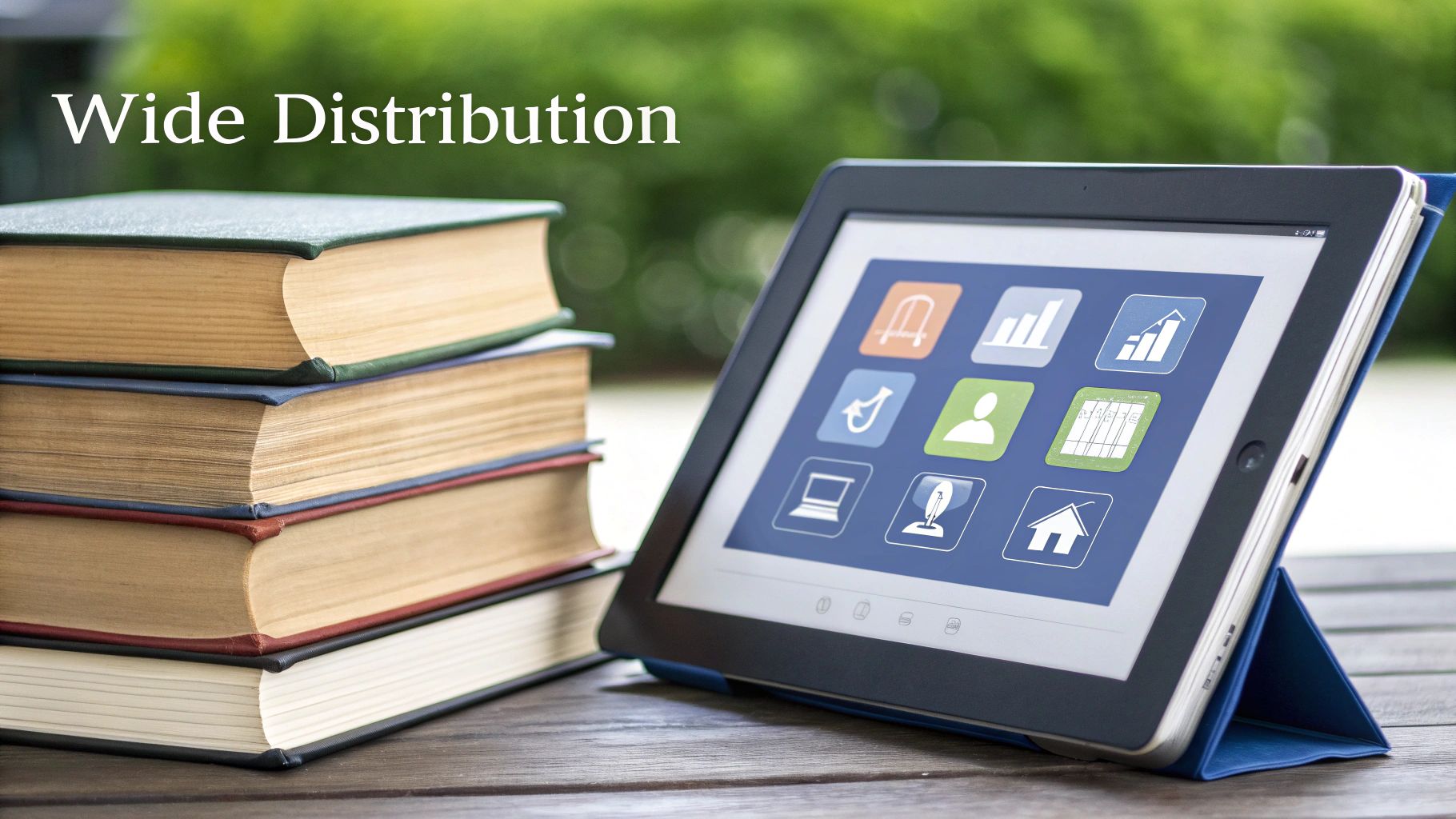
Hitting "publish" might feel like crossing the finish line, but in self-publishing, it's really just the starting gun. Here’s a tough lesson many new authors learn: a great book won't sell itself. A thoughtful, simple launch plan is what separates a successful debut from a book that gets lost in the crowd.
The good news? You don’t need a massive marketing budget or a team of publicists to make a splash. What you do need is a strategy that focuses on repeatable, sustainable tactics—the kind you can build on for your entire writing career. This process should start months before your release date, not the week of.
Start Building Your Audience Early
The single most valuable asset you can have as an author is a direct line to your readers. Social media is great for discovery, but algorithms can change overnight, tanking your reach. An email list, on the other hand, is yours. It's a dedicated group of people who have already raised their hands and said, "Yes, I want to hear from you."
Start building this list long before your book is finished. To get people to sign up, you'll need to offer a compelling incentive—something we call a reader magnet.
- For Fiction Authors: This could be a free short story set in your book's world, a deleted scene, or character art.
- For Non-Fiction Authors: Think about creating a helpful checklist, a quick-start guide, or a resource library related to your book's topic.
A simple author website is the perfect home base for your email list. Platforms like Squarespace or Wix make it easy to set up a professional-looking site in an afternoon, no coding required. You only need a few key pages: a homepage, an "About the Author" page, and a dedicated spot for your books with a clear sign-up form.
Your launch truly begins the moment you start connecting with potential readers. Every email subscriber you gain is one more person who will be ready and waiting to buy your book on day one.
The Power of Early Reviews
Social proof is everything in the online book world. When a potential reader lands on your book's sales page, one of the first things they look for is the star rating and reviews. Books with zero reviews often struggle to gain traction, creating a frustrating catch-22: you need sales to get reviews, but you need reviews to get sales.
The solution is to assemble an Advanced Reader Copy (ARC) team. This is simply a group of dedicated readers who agree to receive a free, early digital copy of your book in exchange for posting an honest review during launch week.
You can recruit your ARC team directly from your new email list and social media followers. The key is to be organized. Set clear expectations about when they should post their reviews and provide them with everything they need, including the book file and direct links to the retail pages. Getting even 5-10 reviews posted on day one can significantly boost your book's visibility in platform algorithms. As you get deeper into the process, a resource like this A to Z Guide for New Product Launches on Amazon can offer valuable insights into the mechanics of a strong debut.
Creating a Simple Launch Week Calendar
Your launch doesn't have to be a frantic, overwhelming experience. A simple calendar helps you stay on track and ensures you hit all the key promotional beats without burning out.
Here’s what a basic, effective launch week could look like:
- Two Days Before Launch: Send one last reminder to your ARC team. Double-check that your book's files and metadata are finalized and correct on your publishing platforms.
- Launch Day: Announce it! Send a celebratory email to your entire list with direct purchase links. Post the news across all your social media channels.
- Day 2: Share something personal. A blog post or social media update with a behind-the-scenes look at your writing process can create a much deeper connection with readers.
- Days 3-4: Gently nudge your ARC team to post their reviews if they haven't already. As positive reviews come in, share snippets on social media to build momentum.
- End of Launch Week: Send a heartfelt "thank you" email to your list, celebrating the launch with them and maybe even dropping a hint about what’s coming next.
This structured approach focuses your energy where it matters most: engaging with the audience you've already built. These foundational techniques are just the beginning, of course. You can always explore more in-depth ideas in our guide to https://barkerbooks.com/book-marketing-strategies-for-books/. By concentrating on these core activities first, you create a powerful and repeatable launch system for every single book you publish.
A Few Common Questions About Self-Publishing
https://www.youtube.com/embed/8tVZamiOZQc
When you're self-publishing a book for the first time, it feels like there are a million questions and not enough clear answers. Getting a handle on these basics is the best way to move forward with confidence and sidestep the common pitfalls that trip up new authors.
Let's break down some of the most frequent things I get asked.
So, How Much Does It Really Cost to Self-Publish a Book?
This is usually the first question on everyone's mind, and for good reason. The budget determines everything.
While you can technically hit "publish" for free by DIY-ing the entire process, that's not the path to a professional book. To create something that can genuinely compete, you need to invest.
For a standard 80,000-word book in 2025, you should plan to spend somewhere between $2,940 and $5,660. That range typically covers the non-negotiables: professional editing ($2,000 – $4,720), a standout cover design (around $880), and clean interior formatting (about $710). And as these in-depth ebook statistics show, your marketing budget is a whole other variable on top of that.
Try not to think of these as costs, but as investments in your book's future. A brilliant edit makes your story sing, and an amazing cover is your single most powerful sales tool. Cutting corners here is the surest way to guarantee your hard work gets ignored.
Do I Actually Need My Own ISBN?
This one trips up a lot of new authors. An ISBN (International Standard Book Number) is your book's unique fingerprint in the global marketplace. Platforms like Amazon KDP will offer to give you one for free, which seems like a great deal on the surface.
But here's the catch: a free ISBN from KDP or another retailer ties your book to their platform exclusively. It also lists them, not you, as the publisher of record.
When you buy your own ISBN from a service like Bowker (in the US), you become the official publisher. This gives you total freedom to sell your book through any retailer, wholesaler, or library you want. It's a small price to pay for complete control over your work.
If your goal is to "go wide" and sell on Apple Books, Barnes & Noble, and Kobo, buying your own ISBN isn't just a good idea—it's essential.
How in the World Do I Get Reviews for My Book?
Ah, the classic chicken-and-egg problem. No one wants to buy a book with zero reviews, but you can't get reviews until people buy it.
The most reliable strategy is to build an ARC (Advanced Reader Copy) team. This is simply a hand-picked group of readers—often pulled from your email list or social media—who get a free digital copy of your book before it's released. Their "job" is to leave an honest review on launch day.
A few tips to make this work:
- Start gathering your ARC team about 4-6 weeks before you launch.
- Give them simple, clear instructions on when and where to post their review.
- Make it incredibly easy for them. Send direct links to the book's page on Amazon, Goodreads, etc.
Even just 5-10 early reviews can make a massive difference. It provides social proof, helps trigger the retailer's algorithms, and encourages that first wave of paying readers to give your book a shot.
Ready to turn your manuscript into a professionally published book that reaches readers worldwide? At BarkerBooks, we handle everything from editing and design to global distribution and marketing, so you can focus on writing. Let's bring your story to life.
